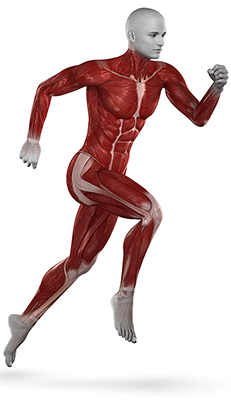
The difference between a muscle spasm and a muscle cramp
A muscle spasm is an involuntary often painful muscle contraction when a signal from the muscle itself causes a reflex muscle contraction at a very high rate. This means that the small plugs (motor neuron) on the muscle does not receive the command from the brain to switch ‘off’. Thus the muscle will not react or relax to voluntary relaxation impulses from the brain. It is usually caused by overuse or over-stimulation of the muscle fibers. Both Muscle spasms and crams can lead to tearing of the muscle.
A muscle can cramp for a few milli-seconds up to a few hours and can be described as an involuntary constant contraction of the muscle fibers. This is due to a lack of nutrients and chemical substances surrounding the muscle fibers which prevents the muscle fiber cells from relaxing. The difference in essence is within the mechanism of how the muscle is deactivated. Muscle spasm via nerve “electrical” impulses and cramps via chemical imbalance.
Causes of muscle spasm
- Overuse – A sudden high repetition of muscle contractions like increasing your running distance too fast.
- Overload – The muscle is subjected to sudden forceful contraction like increasing the leg curl machine too fast. You can just imagine if you jump from 20kg to 40kg in one week. The muscle won’t be able to keep up.
- Overstretch – Muscles are very weak in its stretched position. When the hamstring is forcibly stretched beyond its normal boundaries, the muscle will tear. Running downhills or on a incline will force the muscles to contract from its stretched position.
- Weakness – Muscle fatigue can play a role if you are not strong enough.
- Poor technique – During training (Wrong movement pattern), that can load the muscle incorrectly and stress certain fibers significantly more.
- Poor Management – Neglected injury that has not completely healed.
- Inadequate warm-up – A fast sudden contraction like a jump or start sprinting while the muscle is not prepared for it can put you at risk of tearing the muscle
- Excessive stretching – of the muscle against a force, for example during weight lifting like a deadlift, when the load is applied on both sides of the tendon, while it needs to contract and lengthen at the same time.
- Wrong shoes – Poor support for your foot will cause muscle forces to concentrate along the inside of your leg, which loads those muscle fibers more that the outer part. This abnormal force on the inside of your leg will cause the fibers to fatigue faster.
Types of Muscle Stiffness
- Delayed muscle soreness (DOMS) — This is a common experience where muscles are pushed beyond their boundaries (usually after a heavy workout session)
- The muscle physically shortens, where there is a loss of normal range of movement
- Muscle stiffness can be secondary to a bigger problem. The muscles act to protect a joint.
Repetitive muscle strain
(overuse & overload injury)
These type of muscle strains occur when a muscle needs to contract at a very high rate and force. This overload of ‘pulling’ on the muscle, causes small microscopic tears in the muscle.
Read more on recognizing the warning signs and how we can treat it:
Muscle Contusion/Bruise
A bruise is caused when direct pressure is applied to the muscle. The small blood vessels (called capillaries) within the muscle tear from the pressure and blood plasma escape into the surrounding tissue. This can cause discoloration of the skin but not always.
Treatment of muscle spasm and cramps
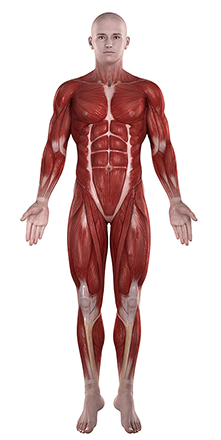
- Heat
Heat can be very effective in treating pain originating from muscles, causing an increase in blood supply to the area to relax the muscle fibers.
Wrap a warm water bottle around a damp towel (dampen to increase conduction of heat energy) apply for 3x 20min intervals. Be careful not to burn yourself. - Ice in a stretched position
Ice must be applied when the muscle fibers are in a stretched position, not in a shortened position. - Stretch
Dynamic stretches are more effective and safer than static (hold) stretches. A dynamic stretch involves stretching the muscle fibers into and out of resistance.
Never stretch into or force through the pain! - Dietary supplements
Monitor your Calcium and Magnesium levels. Adequate supplements can be found in stores. - Medication
Consult your GP in your guidance to take preventative medication or muscle relaxants.
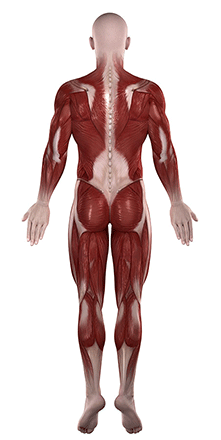
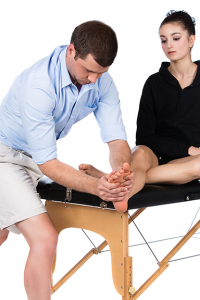
What you shouldn’t do
What you should do
When you have a torn muscle we recommend you follow this regiment to treat, rest and exercise the muscle:
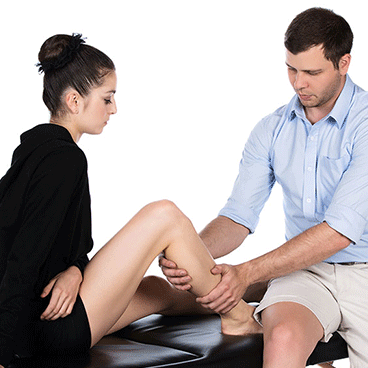
Repetitive muscle strain
Repetitive muscle strains can affect anyone, in any sport, at any time and are there no specific incident at which the injury or pain occur. These type of muscle strains occur when a muscle needs to contract at a very high rate and force. This overload of ‘pulling’ on the muscle causes small microscopic tears in the muscle fibers.
Most common repetitive muscle strains
Strains and tears of the shoulder muscles are very common.
People involved in regular gym work: damage to the biceps tendons and shoulder muscles are relatively common.
- Torn Hamstring muscle (At the back of your leg)
- Calf muscle tear (Gastrocnemius and Soleus muscle tear)
- Thigh muscle tears (Quadriceps muscle tear)
- Groin muscle tears (Adductor group)
- Hip flexors (Tensor Fasica Lata, Iliacus, Psoas muscles)
Spotting a repetitive muscle strain
You will experience pain during an activity, and the pain will progress to feel like a burning pain or cramp right after the activity has stopped. Then you will feel stiffness and tightness after you have cooled down or after a night’s rest. The pain will return when you start the activity again (same pattern). The burning cramp will be a result of inflammatory cells in the injured tissue due to the thousand small tears to the muscle fibers. Increase in tightness and stiffness are also a common sign associated with this fluctuating pain (the pain comes and goes)
The pain intensity is bearable, and more described as a discomfort than pain. A ‘niggling muscle’.
Why does the pain return?
If the rest period is too short, the scar that has formed will be torn apart when you return to training or when you do that specific movement.
Our bodies react to these micro tears by activating the nervous system to tell the muscle it has been injured. Your nervous system will react by contracting that muscle and increasing the muscle tension (to protect itself). The results will be a shortened muscle. The more you stretch it, the more you will damage the scar which is trying to heal the muscle fibers.
Many athletes are able to continue playing through the pain, their body is trying to tell them ‘something is wrong’. People tend to continue training despite the pain, until they realize the pain is only getting worse. Then people tend to stop training for a week. Resting, taking anti-inflammatory medication, but then when they start the activity again…
The pain returns!
Repetitive muscle strain treatment
Treatment focuses on restoring the muscle length. This reduces the force absorbed by the muscle. We will address the pain, inflammation, and guide you on how to reload and strengthen the muscle so you can make the swiftest possible recovery. All your muscles are made of the same substance, so whatever the cause of your muscle pain and wherever it may be, we will get to the root of it. There is no need to suffer.
Muscle tear
Muscles can be damaged by tearing a few thousand of the million small muscle fibers that make up the muscle. Muscles attach to bone from a tendon. Thus every muscle has two tendons, one at the top and one at the bottom, and in the middle all the contactable muscle fibers.
1st degree tear
A mild muscle tear, 10% of muscle fibers torn.
Only a few of the muscle fibers are torn. Less than 20%. These muscles are referred to as a pulled muscle.
Medical treatment
It should heal within a week without treatment. If the pain hasn’t subsided in 3 days, give us a call so we can have a look at it and determine the damage.
Symptoms of a 1st degree muscle tear
- Able to continue playing (sport), able to move.
- Pain only at the end of range (when stretched)
- No loss of muscle strength
- Dull pain when stretched
- Little swelling
- No bleeding seen
- Unable to pinpoint it to one specific spot
2nd degree tear
Moderate muscle tear, 20% – 80% of muscle fibers torn.
Only 20% – 80% of the muscle fibers are torn. After swelling have disappeared (3 days) you should be able to feel a bump or dip where the most painful spot is.
Medical treatment
Contact us A.S.A.P. The faster we have a look at it before the swelling and bleeding gets too much, we can determine where the tear was and how many muscles were torn.
Symptoms of a 2nd degree muscle tear
- Hear a pop or snap when it happens.
- Unable to continue play (sport), have to stop moving.
- Pain through movement
- Loss of muscle strength
- Sharp pain when stretched
- Little to severe swelling
- With or without bleeding under skin
- Able to pinpoint it to one specific spot
3rd degree tear
Severe muscle tear, resulting in the muscle being torn to pieces
The muscle has been torn right through (100% of fibers affected), leaving the muscle in two separate pieces.
Medical treatment
Contact us immediately! The faster we have a look at it before the swelling and bleeding gets too much, we can determine where the tear was and how many muscles were torn.
Depending on the muscles affected, surgery will be required to attach the separate muscle pieces.
Symptoms
- Hearing a loud pop, snap when it happens.
- Unable to continue playing, have to stop moving
- Sever pain through the movement
- Able to contract the muscle, but no movement occurs
- Severe pain when stretched
- Always swelling
- Always considerable amount of bleeding under skin
- Able to pinpoint and see the muscle tear
- Gap or bump visible
Medical scans that can show muscle damage
There are three scans that can show a muscle tear, from least to most expensive they are:
- Sonar
- CT (Computerized tomography scan)
- MRI (Magnetic Resonance Imaging scan)
However it is very rare that we need to take these expensive scans. We deal with this every day and will be able to diagnose a the muscle damage, without the use of these scans.
Nerve damage
Nerves and blood vessels are very sensitive structures that run next to or between muscles and can also be damaged. Nerve damage will give a sharp shooting or burning pain down the limb. In severe cases any numbness or pins & needles could indicate the nerves being damaged. If you experience these symptoms accompanying any muscle pain you should consult a medical practitioner immediately.
Physiological detail of how your muscle heals
Regardless of the underlying cause, the processes occurring in injured muscles tend to follow the same pattern. The rate of recovery varies from one type of injury to another and the magnitude at which your body is capable of restoring itself. You are like Wolverine — you regenerate.
The destruction phase starts with the actual trauma that causes muscle fibers to tear. Immediate necrosis of microfibers takes place due to deterioration of the sarcoplasm, a process that is halted within hours after the trauma by lysosomal vesicles forming a temporary membrane.
An inflammatory process takes place as a reaction on the torn blood vessels. Specialized cells start removing dead cells and parts of the fibers that was damaged.
In the repair and remodeling phase, the actual repair of the injured muscle takes place. Microfibers start regenerating out of satellite cells (= undifferentiated reserve cells) and a connective tissue scar is being formed in the gap between the torn muscle fibers. In the first 10 days after the trauma, this scar tissue is the weakest point of the affected muscle. After 10 days however, eventual re-rupture will rather affect adjacent muscle tissue than the scar tissue itself, although full recovery (up to the point of preinjury strength) can take a relatively long time.
Vascularisation of the injured area is a prerequisite for recovering from a muscle injury. New blood vessels grow from around the injured blood vessels and find their way to the center of the injured area. Early mobilization plays a very important role since it stimulates the blood vessel growth and supply cells to to repair the injured cells. nerves inside the muscle will regenerate to re-establish the nerve-muscle contact.
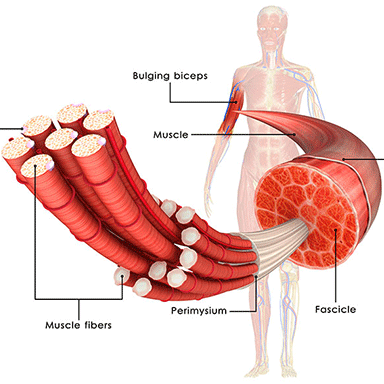
Muscle spasm and cramp treatment
- Acute injury treatment
- Ultrasound
- Medications
- Soft tissue massage
- Electrotherapy treatment
- Laser (Low Level Laser therapy)
- Acupuncture & Dry Needling
- Heat packs (Thermal therapy)
- Kinesiology Tape
- Rigid Strapping or taping
- Neurodynamics (Nerve tissue mobilizations)
- Dynamic Strapping
- Strengthening exercises
- Guided loading protocol
- Stretches (Static, dynamic and ballistic)
- Moon boot
- Brace
- Compression Bandage or Sleeve
- Supportive strapping and taping
- Biomechanical Analysis
- Gait Analysis
- TENS
Torn muscles we see daily
- Hamstring muscle tear (Semimembranosus & Semitendinosus muscles)
- Quadriceps muscle tear (Quadriceps muscles in the front of the thigh)
- Calf muscle tear (Gastrocnemius and Soleus muscles)

